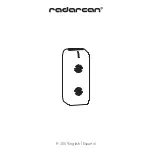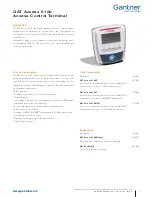
VVT Zone Controller
43
Demand control ventilation (DCV) and dehumidification using optional
sensors
The VVT Zone Controller’s
RH/CO2
input supports an optional CO
2
sensor or Relative Humidity (RH) sensor.
The sensor can have a 5-volt maximum output. The range is configurable as either 0–5 or 1–5 volts (1–5 volt
supports 4–20 mA sensors with a 250 ohm resistor). The controller's low and high sensor input configuration
allows for a wide range of sensors.
The controller can also support both DCV and dehumidification functions, by using a system RH or CO
2
sensor
input connected to another controller.
NOTE
If the connected sensor and/or system sensor value are used by the air source through Linkage, set
the appropriate control type to
Enable
. If you do not need local control at the zone, set
DCV Max Vent Airflow
or
Maximum RH Override Airflow
to 0.
Demand Control Ventilation (DCV)
– Requires CO
2
sensor
The zone controller monitors the CO
2
sensor and can override the temperature control to respond to
increasing CO2 levels when the zone is occupied. If the sensor’s value exceeds the
DCV Start Ctrl Setpoint
and the air source is in cooling or ventilation mode, the controller increases airflow to the zone at a base rate
defined by ASHRAE, and then proportionally increases ventilation if the CO2 level continues to increase. If the
sensor's value exceeds the
DCV Max Ctrl Setpoint
, the controller modulates the damper to its
DCV Max Vent
Damper
Position
.
When the zone is unoccupied, the
Cooling Min Damper Position
and
Heating Min Damper Position
provide
base ventilation.
If the controller is configured for reheat, the heating setpoint is temporarily increased to a value halfway
between the heating and cooling setpoints. If the zone temperature drops below the heating setpoint, the DCV
override is temporarily suspended and the damper returns to normal control until the zone temperature is
satisfied.
Dehumidification
– Requires RH sensor
The zone controller monitors the RH sensor and can provide dehumidification if the sensor's value exceeds
the
Occupied RH Control Setpoint
. If the zone is occupied and does not require heating, and the air source is
operating in a cooling mode and providing primary air with a sufficiently low dew point, the controller
overrides the damper control to increase airflow to the zone. During the dehumidification mode, the heating
setpoint is temporarily increased to a value halfway between the heating and cooling setpoints to prevent
overcooling the zone. The controller uses a PID control loop to provide dehumidification. The controller has a
Maximum RH Override Airflow
setting to prevent excessive airflow during dehumidification.
NOTE
If both control functions are enabled, the zone will control to the greatest calculated damper position of
the three values (temperature, RH, or IAQ
Summary of Contents for OPN-VVTZC
Page 2: ......
Page 27: ...VVT Zone Controller 23 Single duct 2 position hot water Single duct modulating hot water...
Page 79: ......
















































